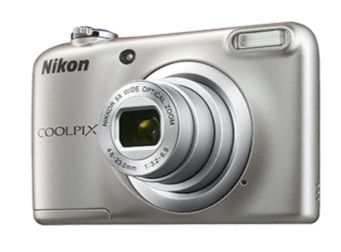Nikon has announced the closure of its Jiangsu, China, digital camera factory in the wake of the ever-greater competition from smartphones. The compact camera market has been decimated from its peak ten years ago, before the launch of the iPhone, and Nikon projects a further 28 percent fall in sales of its low-end models in the year to March 2018.

Smartphone cameras are now so good that there is little sense in carrying a separate compact camera. The sensor size in the best smartphones is now similar to that of the traditional compact camera and the phone software enhancements, including narrow depth-of-field simulation, have overtaken the competition. The cheap point and shoot is now virtually redundant and will gradually disappear.
The fundamental reason for the decline, though, is the convenience of being able to take compelling photographs with the thin phone that you always have in your pocket. For years photographers have clichéd that the best camera is the one in your pocket. Now it is true; it’s in the pocket but isn’t a camera at all. It’s a phone.

The camera industry shouldn’t be too despondent. Smartphones are having a remarkably beneficial effect on camera buying choice. The world of photography is growing as almost everyone with a smartphone begins to explore possibilities, from selfies to some really sophisticated work. Apple has been at great pains to show how its iPhones can produce stunning results, even using pictures in poster advertising. All this raises awareness in photography. While this has been bad news for the cheaper end of the market, premium brands such as Fuji, Sony, Canon, Nikon, Olympus and Panasonic are benefiting.
The smartphone camera flatters to deceive. It is much easier to get ostensibly perfect photographs from a modern phone than it was from the compact point-and-shoot in its heyday. Buoyed with this new enthusiasm for photography, many millions of phone owners throughout the world are prompted to look a little further — perhaps in the direction of one of today’s range of high-end compacts with larger sensors. It’s a clear step up and I believe that this new enthusiasm will work up from the bottom of the market — from the DSLR starter kit or a one-inch sensor compact — to full-frame and, even, medium-format digital photography. The prospects for the new mirrorless cameras have never been rosier. Fuji, Sony and others are leading the way, while a micro four-thirds system is also making strong inroads.
News of contraction in the compact camera market is thus not to be seen as the death-knell for the traditional camera. Instead, it is a symbol of a re-awakening in interest in photography, something we should all welcome. There’s life in the old dog yet.
Read: Leica M10 versus the Samsung Galaxy Note 8
_____________

Having been a photo retailer back in the P&S heyday (1990’s), it has been a shame to see what has transpired in the marketplace. I’m glad I am not in the business anymore, as there is no way to compete with the ubiquitous smart phone/cameras. The big guys (Canon, Nikon, et al) response has been pathetic. No one can honestly say they weren’t asleep at the wheel while the smart phone companies stole their market from them. Without the vast pool of amateurs buying P&S cameras, where will the money come from to fund the high end cameras?
Leica, on the other hand, seems to be quite smart in partnering with a smart phone manufacturer. Why didn’t Canon, Nikon or any of the others follow this path?
Image transfer apps work pretty well for transferring images from my "good" camera to my smart phone or someone else’s smart phone. I have used the FujiFilm app quite successfully with my Fuji XE-2. Now with my M10, the Leica app works pretty well too, although I was having a hard time with it without Stefan Daniel’s help at the Chicago meeting!
Comparison between tomato and potato 😀. Tomato is tomato and potato is potato – period.
No longer true. Potato is now tomato. Just go to any tourist attraction and count the number of cameras and the number of smartphones.
William
Absolutely right. The camera manufacturers have been woefully inadequate in their response. To transmit your images anywhere (even to your computer) from a non smartphone camera has been difficult because you have to go through too many stages of non intuitive procedure to achieve what a smartphone user can achieve in seconds. Helpfully (!) the camera manufacturers have provided their inhouse software solutions which are optimistically sold as a bridge or a "world"in which to organise, uplaod and share images. Almost universally I think, the capabilities are clunky, unintuitive and not focussed on making life easier for the user. This is world class failure to read what is happening in the market.
"I have a dream" where much of what I now do on my computer is done within my camera with a few swift button presses and perhaps a few top level menu choices. Another button prepares my Americano with cold milk for instant availability in the field!
There is one snag. To steamline the process, cameras would need cellular connection and that would mean yet another SIM card and subscription. I am not sure that it would be worthwhile. The smartphone wins because it has a permanent connection. The best I think the camera manufacturers could offer is an instant connection via the phone.
I agree that camera manufacturers would be most unwise to take on the smartphone manufacturers headon. I do however believe that they are still in denial that they have a software problem. Canon, Nikon et al are poor followers and not leaders in software to help you use your camera. There is an awful lot they could do to help without installing cellular connection. It should be easy to choose in camera which folder on my computer a particular image or group of images need to go so that when I get home this happens with no further action. As soon as my camera detects my home wifi network, it automatically does the transfer to the right folder.
It is my belief that camera manufacturers see software (other than firmware) as a regrettable cost. For example, Nikon offered Capture NX as a professional editing solution. In about 2007 it was cutting edge since it offered easy selective editing via control points. It was a dog because Nikon were always 6-9 months behind in updating Capture NX to work with new OS updates so you had the choice: forgo an OS update or forgo Capture NX. I gave up Capture NX in 2009 and Nikon soon after.
Camera manufacturers must accept they have a problem before they can actually meet customer needs and delight the user in a similar but not identical way to the smartphone manufacturers.
Internet connectivity via wi-fi should be sufficient. Can you imagine the charges from Vodafone etc for using networks to send large data packets from top end cameras? On the other hand for most people their auntie in Australia is not going to start pixel peeping at the photo of their niece/nephew standing in front of the Trevi Fountain. And that smartphone photo is going to continue to get better image quality-wise. The battle is over. As others have said, the camera companies have sleep-walked their way through this. The knock on for ‘serious camera users’ is that your cameras are going to get more expensive as production numbers of stand alone cameras generally continue to fall.
William
You are right. Far more people than ever before are taking photos because of smartphones. This has come along as part of a communications revolution in which photographs can be sent to the far end of the globe within a few seconds after capture. Cameras with full communications functions will be essential to hold onto the non professional market. I am surprised that there has not been more progress in regard to this. Smartphones, which intrinsically have full built in communications functions, continue to improve as regards image quality and photographic functionality all of the time. This is only going to go one way unless camera manufacturers act on this.
William
I hope that Ricoh’s GR is not being caught up in this collapse. There is no way that either a smart phone or an ILC could replace my GR 🙁
Completely agree Mark. While my smartphone is much more convenient because of it’s connectivity and the range of other aps it can run, there is no way it can compete with the GR, M10 or X-Pro2 for dynamic range and lack of JPG artifacts. The smartphone camera aps are clever, but software can only go so far before the picture stars to look very artificial. Give me high dynamic range without a lot of noise reduction or other messing with the image any day over the ability to post to Facebook in seconds!